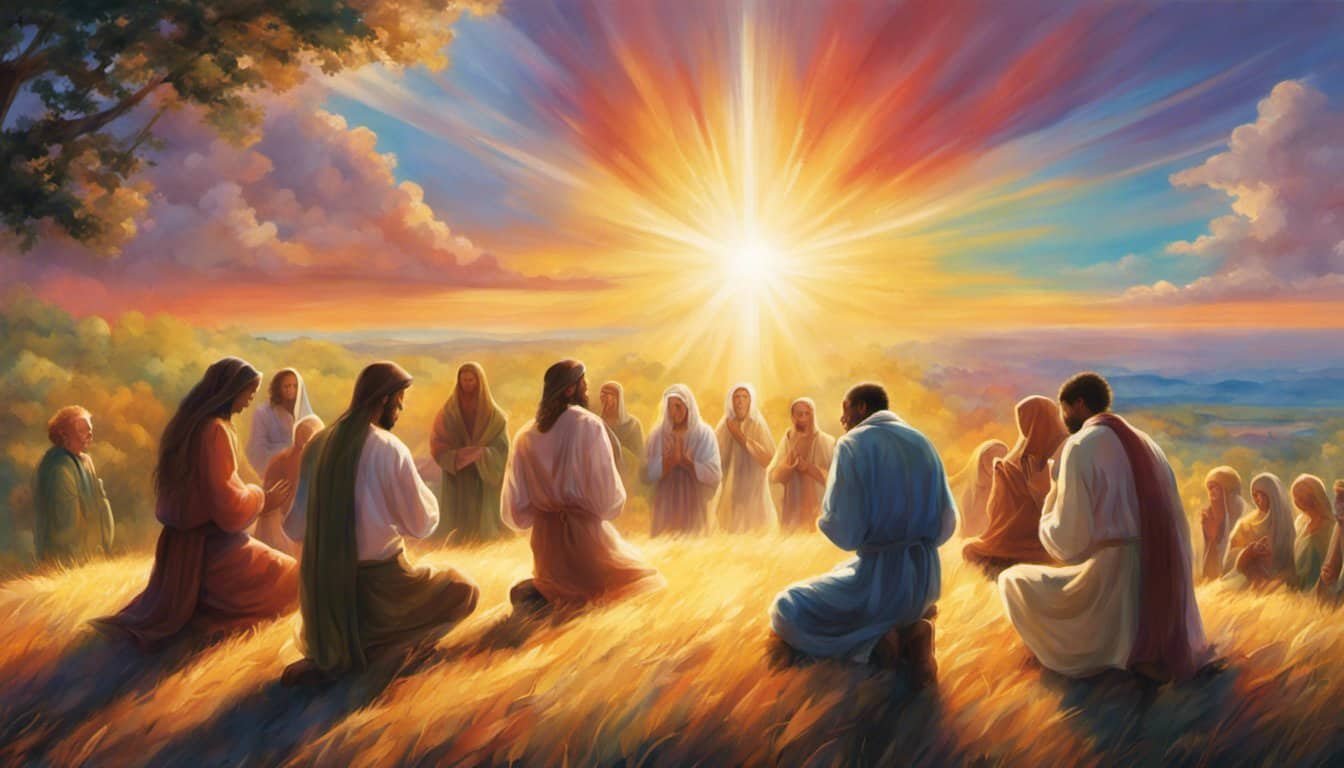When I first started exploring the Bible, the Old Testament felt like a vast, mysterious world. It’s packed with ancient stories, laws, and poetry that have shaped countless lives and cultures over millennia. But what exactly is the Old Testament, and why is it so significant?
The Old Testament, also known as the Hebrew Bible, is a collection of religious texts sacred in both Judaism and Christianity. It consists of various books, including historical narratives, wisdom literature, and prophetic writings. These texts not only provide a historical record of the ancient Israelites but also offer profound insights into human nature, morality, and the divine. Curious to dive in? Let’s explore what makes the Old Testament such a cornerstone of faith and history.
Understanding the Old Testament

The Old Testament forms a significant part of the Bible, containing vital stories and teachings that have shaped faith and history for thousands of years. Let’s dive into its origins, structure, key themes, and messages for a better grasp.
Origins and Structure
The Old Testament, or Hebrew Bible, includes a collection of texts written over many centuries. These texts originated in ancient Israel and surrounding regions and were compiled into the current form over time. The Old Testament is divided into several sections:
- The Torah (Law): These five books—Genesis, Exodus, Leviticus, Numbers, and Deuteronomy—outline the early stories of humanity and God’s covenants with Israel.
- Historical Books: Books like Joshua, Judges, Samuel, and Kings narrate the history of the Israelites from their conquest of Canaan to their exile in Babylon.
- Wisdom Literature: Texts including Psalms, Proverbs, and Ecclesiastes offer insights into human nature and divine wisdom.
- Prophetic Writings: Books such as Isaiah, Jeremiah, and Ezekiel portray prophets who relayed God’s messages to the people, addressing both hope and judgment.
Key Themes and Messages

The Old Testament conveys numerous themes and messages central to understanding its purpose and relevance. Here are some of the key ones:
- Covenant: God makes covenants with individuals like Noah and Abraham and with the nation of Israel. These covenants highlight God’s commitment and the people’s obligations.
- Law and Morality: The Ten Commandments and other laws provided moral and ethical guidance, influencing societal standards even today.
- Faith and Obedience: Many stories, like those of Noah, Abraham, and Moses, stress the importance of trusting and obeying God amidst challenges.
- Justice and Mercy: Prophets called out injustices, urging a return to righteous living and promising God’s mercy for those who repent.
- Hope and Redemption: Despite the people’s frequent failings and the resulting consequences, there is always a theme of hope and the promise of eventual redemption.
The Old Testament’s rich tapestry of stories and teachings offers endless lessons and reflections relevant to both historical contexts and contemporary life.
Historical Context of the Old Testament
Understanding the historical context of the Old Testament offers a clearer perspective on its teachings and narratives. This context is crucial for anyone looking to delve deeper into the significance of these ancient texts. Let’s explore a few critical aspects that shape this historical backdrop.
Authorship and Compilation
The Old Testament, also known as the Hebrew Bible, was written over centuries. Multiple authors contributed, with some books attributed to known prophets while others remain anonymous. For example, Moses is traditionally credited with the first five books, known as the Torah. These books set the foundation of Jewish law and tradition.
The compilation of the Old Testament wasn’t a quick process either. Over several centuries, these texts were written, edited, and compiled. Historical records suggest that the Babylonian exile (around the 6th century BCE) was a significant period for the compilation and redaction of many texts. This period of exile profoundly impacted Jewish thought, leading to the collection and preservation of their sacred writings.
Impact on Ancient Societies
The Old Testament didn’t just influence religious practices; it shaped entire societies. In ancient Israel, the laws and teachings in these texts governed daily life, from moral conduct to societal rules. For instance, the Ten Commandments provided a moral and ethical framework that influenced not just Israelites but many civilizations following them.
In addition to legal and moral guidelines, the Old Testament played a vital role in rituals and worship. The Psalms, for instance, were used in temple worship, creating a sense of communal identity and spiritual practice. The prophetic books, like those of Isaiah and Jeremiah, called for social justice and faithfulness, directly impacting how societies viewed leadership and justice.
So, as you read through the Old Testament, keep in mind the rich historical context that shaped these writings. This understanding will enrich your study and appreciation of these foundational texts.
Literary Forms in the Old Testament
Understanding the various literary forms in the Old Testament enriches one’s appreciation of its teachings and narratives. These forms give us different lenses through which to view the themes and lessons presented. Let’s dive into two prominent forms found in these ancient texts.
Poetry and Prophecy
In the Old Testament, poetry plays a crucial role in expressing emotions, thoughts, and divine messages. Books like Psalms and Proverbs are prime examples. The Psalms, with their lyrical and often rhythmic language, offer praises, laments, and prayers to God. Many of David’s psalms reflect his highs and lows, making them relatable and timeless. For example, Psalm 23 provides comfort with its familiar lines about the Lord being a Shepherd.

Prophecy, found in books like Isaiah, Jeremiah, and Ezekiel, delivers God’s messages to His people, often warning them and calling for repentance. These prophetic texts aren’t just about foretelling future events but also providing insights and guidance about maintaining a faithful relationship with God. Isaiah 9:6, for instance, speaks of the coming Messiah, offering hope and a promise of salvation.
Law and Narrative
The Old Testament’s legal texts, mainly found in the Torah (Genesis, Exodus, Leviticus, Numbers, Deuteronomy), lay down commandments and regulations for living a life obedient to God. These laws cover everything from worship practices to social justice, reflecting God’s covenant with His people. For instance, the Ten Commandments in Exodus 20 outline fundamental principles for ethical behavior and worship.
Narrative accounts present historical and theological stories that illustrate God’s interactions with humanity. Whether it’s the creation story in Genesis, the Exodus from Egypt, or the conquest of Canaan, these narratives provide context and background for understanding God’s promises and the people’s history. They also offer moral and spiritual lessons that remain relevant today. The story of Joseph, for instance, demonstrates perseverance and faith amid adversity.
Exploring these literary forms helps deepen one’s understanding of the old Testament and its multifaceted approach to conveying divine wisdom and guidance.
Major Figures in the Old Testament
The Old Testament features a variety of significant personalities whose lives and actions have shaped the faith and history of Judaism and Christianity.
Prophets and Kings
Figures like Moses and David play pivotal roles. Guided by God, Moses leads the Israelites out of Egypt and receives the Ten Commandments. David, crowned as Israel’s King and known for his musical and poetic prowess, authors many Psalms. Elijah, another major prophet, confronts idolatry and performs miracles like calling down fire on Mount Carmel.
Key Prophets and Kings:
- Moses: Leads Israelites from slavery, receives Ten Commandments.
- David: Shepherd who becomes King, writes Psalms, defeats Goliath.
- Elijah: Performs miracles, confronts Baal worship.
Influential Women
Women like Ruth and Esther stand out for their courage and faith. Ruth, a Moabite, shows loyalty to her mother-in-law Naomi and becomes the great-grandmother of David. Esther, a Jewish queen in Persia, saves her people from a massacre through bravery and strategic thinking. Hannah, the mother of Samuel, dedicates her son to God’s service and exemplifies trusting prayer.
- Ruth: Loyal daughter-in-law, David’s ancestor.
- Esther: Saves Jews in Persia, renowned for bravery.
- Hannah: Samuel’s mother, exemplifies prayer and dedication.
These figures, both male and female, inspire readers with their faith, leadership, and dedication to God’s will.
The Old Testament’s Influence on Modern Religion
When reflecting on modern religion, the Old Testament plays a crucial role in shaping beliefs and practices across various faiths. It’s a fundamental part of both Christianity and Judaism.
Christianity and Judaism
For Christians, the Old Testament sets the stage for the New Testament. It lays down prophecies regarding the Messiah, which Christians believe Jesus fulfilled. Key texts like Isaiah 53 and Psalm 22 are often cited in sermons to show these prophecies. The Torah’s laws and stories of faith from Abraham, Moses, and David offer Christians lessons on obedience and God’s promises.

Judaism, on the other hand, revolves around the Old Testament, known to Jews as the Tanakh. It’s more than scripture; it’s a guide for daily life. Observant Jews follow the 613 commandments in the Torah, and the Talmud provides detailed commentary on these laws. Stories of the patriarchs and matriarchs, like Sarah, Jacob, and Rachel, foster a rich cultural heritage, binding Jews to their ancient lineage.
Interpretations and Controversies
Interpretations of the Old Testament vary widely, sparking debates among theologians and scholars. One contentious area is the creation story in Genesis. Some argue for a literal six-day creation, while others see it as symbolic, raising questions about the compatibility of faith and science.
Historical accuracy is another hot topic. Archaeologists and historians sometimes challenge biblical narratives, like the Exodus. While some findings support biblical events, others contradict them, leaving room for debate.
And let’s not forget the ethical dilemmas. Passages in Leviticus and Deuteronomy contain dietary laws and moral codes that modern readers might find harsh or outdated. These texts are often scrutinized for their relevance today. For instance, discussions about gender roles and social justice take cues from these ancient writings, influencing contemporary religious and ethical views.
The Old Testament’s layers of history, law, and prophecy continue to shape the beliefs and practices of billions. Whether you’re a devout believer or a curious scholar, understanding these ancient texts offers a deeper appreciation of their lasting impact.
Conclusion

Exploring the Old Testament is like diving into a vast ocean of history, faith, and wisdom. It’s fascinating to see how these ancient texts continue to shape our modern world, influencing both religious practices and ethical discussions. Whether you’re a believer or just curious, there’s so much to learn and appreciate. The stories, lessons, and prophecies within the Old Testament offer timeless insights that resonate across generations. So, next time you pick up a Bible or hear a reference to these texts, you’ll have a richer understanding of their profound significance.
Frequently Asked Questions
What is the Old Testament?
The Old Testament, known in Judaism as the Hebrew Bible or Tanakh, is a collection of religious texts foundational to both Judaism and Christianity. It contains books that explore themes like covenant, law, and redemption.
Who are some key figures in the Old Testament?
Key figures include Moses, who led the Israelites out of Egypt; David, King of Israel; and Ruth, whose story exemplifies loyalty and faith.
How does the Old Testament influence modern religion?
In Christianity, the Old Testament sets the stage for the New Testament and includes prophecies about the Messiah. In Judaism, it guides daily life with commandments and stories of patriarchs and matriarchs.
What themes are explored in the Old Testament?
The Old Testament explores themes such as covenant, law, faith, justice, mercy, hope, and redemption.
How is the Old Testament interpreted?

Interpretations vary, often leading to debates on creation, historical accuracy, and ethical dilemmas, influencing contemporary religious and ethical views.
What is the significance of the Old Testament in Christianity?
The Old Testament is significant for its prophecies about the coming of the Messiah and its foundational lessons on obedience, which set the stage for the New Testament.
What is the significance of the Old Testament in Judaism?
In Judaism, the Old Testament, or Tanakh, is central and guides daily life through its commandments and stories of the patriarchs and matriarchs.
Why is understanding the Old Testament important?
Understanding the Old Testament offers a deeper appreciation of its lasting impact on billions of believers and scholars, enriching contemporary religious and ethical views.












